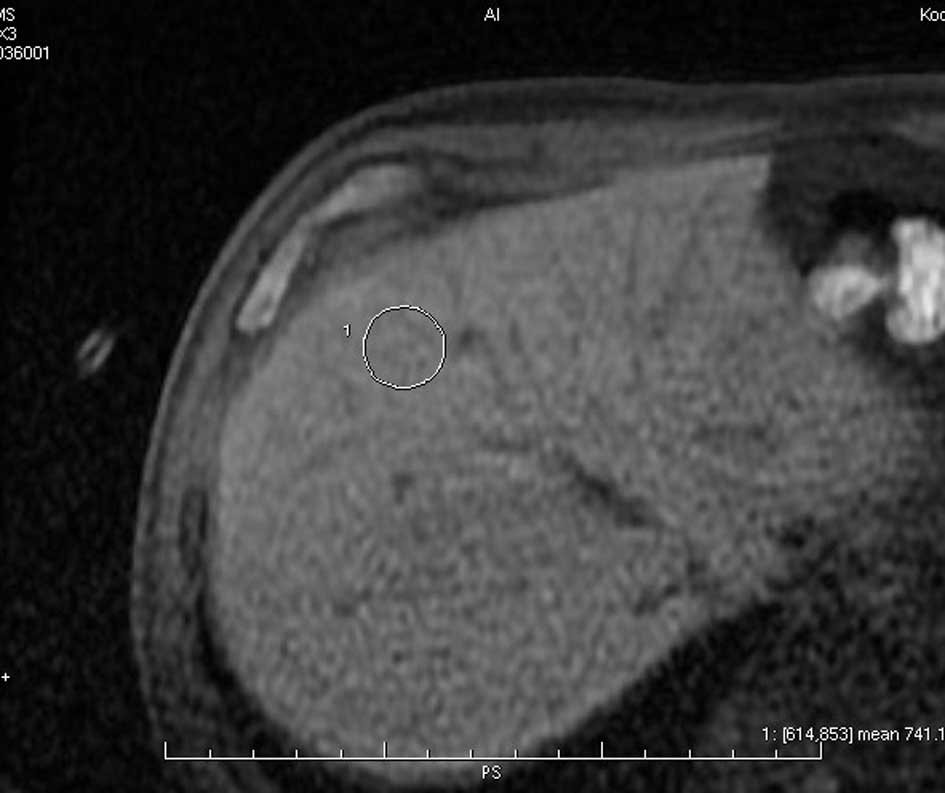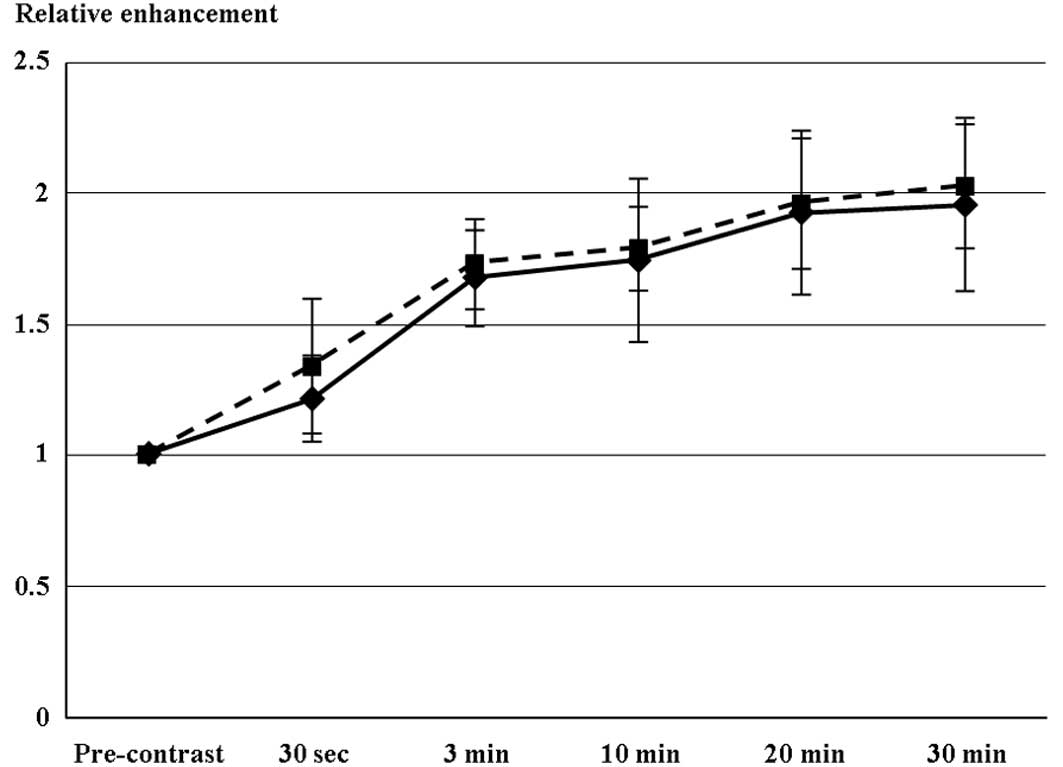|
1
|
Hamm B, Staks T, Muhler A, et al: Phase I
clinical evaluation of Gd-EOB-DTPA as a hepatobiliary MR contrast
agent: safety, pharmacokinetics, and MR imaging. Radiology.
195:785–792. 1995. View Article : Google Scholar : PubMed/NCBI
|
|
2
|
Vogl TJ, Kummel S, Hammerstingl R, et al:
Liver tumors: comparison of MR imaging with Gd-EOB-DTPA and
Gd-DTPA. Radiology. 200:59–67. 1996. View Article : Google Scholar : PubMed/NCBI
|
|
3
|
Reimer P, Rummeny EJ, Shamsi K, et al:
Phase II clinical evaluation of Gd-EOB-DTPA: dose, safety aspects,
and pulse sequence. Radiology. 199:177–183. 1996. View Article : Google Scholar : PubMed/NCBI
|
|
4
|
Reimer P, Rummeny EJ, Daldrup HE, et al:
Enhancement characteristics of liver metastases, hepatocellular
carcinomas, and hemangiomas with Gd-EOB-DTPA: preliminary results
with dynamic MR imaging. Eur Radiol. 7:275–280. 1997. View Article : Google Scholar : PubMed/NCBI
|
|
5
|
Stern W, Schick F, Kopp AF, et al: Dynamic
MR imaging of liver metastases with Gd-EOB-DTPA. Acta Radiol.
41:255–262. 2000. View Article : Google Scholar : PubMed/NCBI
|
|
6
|
Huppertz A, Balzer T, Blakeborough A, et
al: Improved detection of focal liver lesions at MR imaging:
multicenter comparison of gadoxetic acid-enhanced MR images with
intraoperative findings. Radiology. 230:266–275. 2004. View Article : Google Scholar : PubMed/NCBI
|
|
7
|
Bluemke DA, Sahani D, Amendola M, et al:
Efficacy and safety of MR imaging with liver-specific contrast
agent: U.S. multicenter phase III study. Radiology. 237:89–98.
2005. View Article : Google Scholar : PubMed/NCBI
|
|
8
|
Huppertz A, Haraida S, Kraus A, et al:
Enhancement of focal liver lesions at gadoxetic acid-enhanced MR
imaging: correlation with histopathologic findings and spiral CT -
initial observations. Radiology. 234:468–478. 2005. View Article : Google Scholar : PubMed/NCBI
|
|
9
|
Zech CJ, Grazioli L, Breuer J, Reiser MF
and Schoenberg SO: Diagnostic performance and description of
morphological features of focal nodular hyperplasia in
Gd-EOB-DTPA-enhanced liver magnetic resonance imaging: results of a
multicenter trial. Invest Radiol. 43:504–511. 2008. View Article : Google Scholar
|
|
10
|
Hammerstingl R, Huppertz A, Breuer J, et
al: Diagnostic efficacy of gadoxetic acid (Primovist)-enhanced MRI
and spiral CT for a therapeutic strategy: comparison with
intraoperative and histopathologic findings in focal liver lesions.
Eur Radiol. 18:457–467. 2008. View Article : Google Scholar
|
|
11
|
Bollow M, Taupitz M, Hamm B, Staks T, Wolf
KJ and Weinmann HJ: Gadolinium-ethoxybenzyl-DTPA as a hepatobiliary
contrast agent for use in MR cholangiography: results of an in vivo
phase-I clinical evaluation. Eur Radiol. 7:126–132. 1997.
View Article : Google Scholar : PubMed/NCBI
|
|
12
|
Asbach P, Warmuth C, Stemmer A, et al:
High spatial resolution T1-weighted MR imaging of liver and biliary
tract during uptake phase of a hepatocyte-specific contrast medium.
Invest Radiol. 43:809–815. 2008. View Article : Google Scholar : PubMed/NCBI
|
|
13
|
Clement O, Muhler A, Vexlar V, Berthezene
Y and Brasch RC: Gadolinium-ethoxybenzyl-DTPA, a new liver-specific
magnetic resonance contrast agent. Kinetic and enhancement patterns
in normal and cholestatic rats. Invest Radiol. 27:612–619. 1992.
View Article : Google Scholar : PubMed/NCBI
|
|
14
|
Muhler A, Freise CE, Kuwatsuru R, et al:
Acute liver rejection: evaluation with cell-directed MR contrast
agents in a rat transplantation model. Radiology. 186:139–146.
1993. View Article : Google Scholar : PubMed/NCBI
|
|
15
|
Muhler A, Heinzelmann I and Weinmann HJ:
Elimination of gadolinium-ethoxybenzyl-DTPA in a rat model of
severely impaired liver and kidney excretory function. An
experimental study in rats. Invest Radiol. 29:213–216. 1994.
View Article : Google Scholar : PubMed/NCBI
|
|
16
|
Schmitz SA, Muhler A, Wagner S and Wolf
KJ: Functional hepatobiliary imaging with gadolinium-EOB-DTPA. A
comparison of magnetic resonance imaging and 153gadolinium-EOB-DTPA
scintigraphy in rats. Invest Radiol. 31:154–160. 1996. View Article : Google Scholar : PubMed/NCBI
|
|
17
|
Kim T, Murakami T, Hasuike Y, et al:
Experimental hepatic dysfunction: evaluation by MRI with
Gd-EOB-DTPA. J Magn Reson Imaging. 7:683–688. 1997. View Article : Google Scholar : PubMed/NCBI
|
|
18
|
Ryeom HK, Kim SH, Kim JY, et al:
Quantitative evaluation of liver function with MRI using
Gd-EOB-DTPA. Korean J Radiol. 5:231–239. 2004. View Article : Google Scholar : PubMed/NCBI
|
|
19
|
Makuuchi M, Kokudo N, Arii S, et al:
Development of evidence-based clinical guidelines for the diagnosis
and treatment of hepatocellular carcinoma in Japan. Hepatol Res.
33:37–51. 2008. View Article : Google Scholar : PubMed/NCBI
|
|
20
|
Clement O, Muhler A, Vexler VS, et al:
Evaluation of radiation-induced liver injury with MR imaging:
comparison of hepatocellular and reticuloendothelial contrast
agents. Radiology. 185:163–168. 1992. View Article : Google Scholar : PubMed/NCBI
|
|
21
|
Kaplowitz N: Physiological significance of
glutathione S-transferases. Am J Physiol. 239:G439–G444.
1980.PubMed/NCBI
|
|
22
|
Schuhmann-Giampieri G, Schmitt-Willich H,
Press WR, Negishi C, Weinmann HJ and Speck U: Preclinical
evaluation of Gd-EOB-DTPA as a contrast agent in MR imaging of the
hepatobiliary system. Radiology. 183:59–64. 1992. View Article : Google Scholar : PubMed/NCBI
|
|
23
|
Kwon AH, Ha-Kawa SK, Uetsuji S, Inoue T,
Matsui Y and Kamiyama Y: Preoperative determination of the surgical
procedure for hepatectomy using technetium-99m-galactosyl human
serum albumin (99mTc-GSA) liver scintigraphy. Hepatology.
25:426–429. 1997. View Article : Google Scholar
|
|
24
|
Lau H, Man K, Fan ST, Yu WC, Lo CM and
Wong J: Evaluation of preoperative hepatic function in patients
with hepatocellular carcinoma undergoing hepatectomy. Br J Surg.
84:1255–1259. 1997. View Article : Google Scholar : PubMed/NCBI
|
|
25
|
Shimizu J, Dono K, Gotoh M, et al:
Evaluation of regional liver function by
gadolinium-EOB-DTPA-enhanced MR imaging. Dig Dis Sci. 44:1330–1337.
1999. View Article : Google Scholar : PubMed/NCBI
|
|
26
|
Tsuda N, Okada M and Murakami T: Potential
of gadolinium- ethoxybenzyl-diethylenetriamine pentaacetic acid
(Gd-EOB- DTPA) for differential diagnosis of nonalcoholic
steatohepatitis and fatty liver in rats using magnetic resonance
imaging. Invest Radiol. 42:242–247. 2007. View Article : Google Scholar
|
|
27
|
Ono M and Saibara T: Clinical features of
nonalcoholic steatohepatitis in Japan: Evidence from the
literature. J Gastroenterol. 41:725–732. 2006. View Article : Google Scholar : PubMed/NCBI
|
|
28
|
Shimada M, Hashimoto E, Taniai M, et al:
Hepatocellular carcinoma in patients with non-alcoholic
steatohepatitis. J Hepatol. 37:154–160. 2002. View Article : Google Scholar : PubMed/NCBI
|
|
29
|
Asanuma T, Ono M, Kubota K, et al: Super
paramagnetic iron oxide MRI shows defective Kupffer cell uptake
function in non-alcoholic fatty liver disease. Gut. 59:258–266.
2010. View Article : Google Scholar : PubMed/NCBI
|
|
30
|
Saadeh S, Younossi ZM, Remer EM, et al:
The utility of radiological imaging in nonalcoholic fatty liver
disease. Gastroenterology. 123:745–750. 2002. View Article : Google Scholar : PubMed/NCBI
|
|
31
|
Murata Y, Ogawa Y, Saibara T, et al:
Tamoxifen-induced non-alcoholic steatohepatitis in patients with
breast cancer: Determination of a suitable biopsy site for
diagnosis. Oncol Rep. 10:97–100. 2003.PubMed/NCBI
|
|
32
|
Kubota K, Hisa N, Fujiwara Y, Fukumoto M,
Yoshida D and Yoshida S: Evaluation of the intratumoral vasculature
of hepatocellular carcinoma by power Doppler sonography: advantages
and disadvantages versus conventional color Doppler sonography.
Abdom Imaging. 25:172–178. 2000. View Article : Google Scholar
|
|
33
|
Kubota K, Hisa N, Nishikawa T, Ohnishi T,
Ogawa Y and Yoshida S: The utility of tissue harmonic imaging in
the liver: A comparison with conventional gray-scale sonography.
Oncol Rep. 7:767–771. 2000.PubMed/NCBI
|
|
34
|
Kubota K, Hisa N, Nishikawa T, et al:
Evaluation of hepatocellular carcinoma after treatment with
transcatheter arterial chemoembolization: comparison of
Lipiodol-CT, power Doppler sonography, and dynamic MRI. Abdom
Imaging. 26:184–190. 2001. View Article : Google Scholar
|
|
35
|
Kubota K, Yamanishi T, Itoh S, et al: Role
of diffusion-weighted imaging in evaluating therapeutic efficacy
after transcatheter arterial chemoembolization for hepatocellular
carcinoma. Oncol Rep. 24:727–732. 2010. View Article : Google Scholar
|
















